
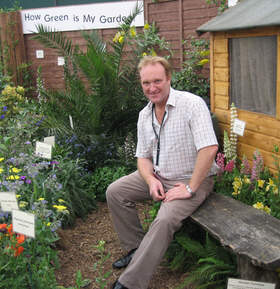
The exhibit is an environmentally friendly garden centring upon issues such as recycling, water use, sustainable practices and 'garden miles', which determine how far the contents of the garden are physically transported and at what cost. The aim of the exhibit is to educate gardeners about what they can do to improve their environmental credentials. The team used as many recycled products as they could in order to reduce the environmental impact of their own efforts.
Mick Lavelle [pictured], Senior Lecturer and team leader for show preparations, said: I'm really pleased that the exhibit received a Silver Lindley. The students involved were all first year degree students and receiving this accolade is testament to their hard work. This will be the last Chelsea for me, and it's great to bow out with one last medal.
Sponsors of the College's exhibit include The Sun Newspaper, Roofdragon.com and JNC Landscapes, Harlow.
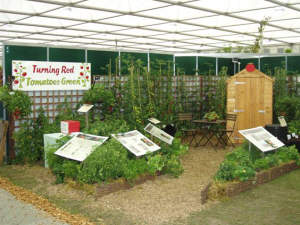
Tomatoes are one of the most popular and widely grown summer crops in the UK. The aim of Writtle College's 'Turning Red Tomatoes Green' exhibit is to demonstrate to gardeners how tomatoes can be produced in an environmentally friendly way, without sacrificing the yield or quality of the fruit.
A team at the college ran trials in 2005 and developed a growth medium using products derived by composting from plant waste materials. This medium was used to grow plants in that produced tomatoes that matched yield, size, taste and appearance to those grown under comparable conditions in commercial grow bags.
What is so green about our tomatoes?
We also incorporated companion plants such as Tagetes, chives and Nasturtium in with the tomatoes. These can benefit the tomato plants by diverting the attention of pests by either masking the scent of the crop plant or by being more attractive to the pests themselves
Download the 2006 leaflet / 2006 website
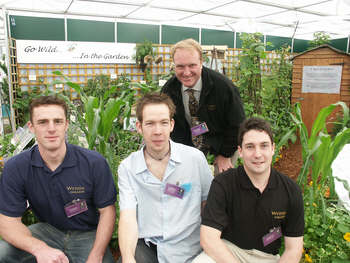
This year's display, entitled 'A Taste of the Wild,' shows how a garden can benefit wildlife whilst still looking good.
The students took the unusual step of attempting to create a garden landscape that is also edible for humans, one packed with vegetables, fruit and some more unusual edible plants. The idea is to show how wildlife gardens can be a complete package; beautiful, full of wildlife and life sustaining for all the occupants. Three main groups of wildlife feature in this display - butterflies, birds and bees. The bees will also have their own live presence, with a live hive of Bumble Bees being featured to try and help people better understand the role and importance of these threatened and harmless garden dwellers.
Students once again be working under the direction of Chelsea show 'veteran' and Writtle College lecturer Mick Lavelle.
Mick Lavelle said: The object is not to suggest that this type of garden can sustain all human needs of course. Indeed it could be said to be a novelty by some. The serious message however is that there are a lot of native (and non native) plant species that can be used for culinary purposes. People often become somewhat one track in the garden, preferring their space to be a vegetable plot, amenity area or wildlife area. Why not combine the three in an informal way that provides enjoyment, aesthetic appeal and a sustainable habitat for much of our own threatened wildlife?
The College also had a second floral exhibit (Bronze) in conjunction with The Sun newspaper. It consists of a seven metre pyramid of foxgloves rising from a base of carnations. The foxglove was a new variety in 2004 but the carnations are all new for 2005. In addition to Mick Lavelle, TV gardener Peter Seabrook were on hand with Sun garden writer Steve Bradley to help and encourage the students.
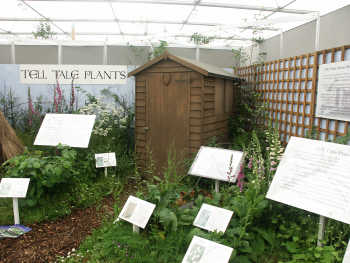
The display, called 'Tell Tale Plants', used 20 species of plant to highlight the rich cultural heritage of plant names and stories.
The colourful exhibit comprises three sections that will look at the myth and legend behind plants including folklore, plant lore and garden lore.
The 'Plant Stories' section showed that many native British plants have a profusion of stories and folklore attached to them. Many of these are interesting or funny but almost always relate to their usefulness to humanity.
The 'What's in a Name' section looked at vernacular plant names and what they can tell us. It was primarily concerned with how plant names reveal a story, a use or details of the way that they fit into their natural environment.
The final section looked at how plants help us to make connections with the natural world. It revealed how tradition and plant lore can reveal wisdom yet to be 'discovered' by western science. Much of this wisdom is still held by civilisations in the less developed world but is in real danger of being lost as countries rapidly develop. Such knowledge can help scientists in the developing world to develop new products, generate income and add value to the environment.
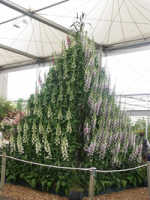
Mick Lavelle, co-ordinator of the exhibit and senior lecturer in landscape management at Writtle College said: "Every plant has a story to tell and even the commonest ones deserve a second look. I want to encourage people to look at plants more closely to find out what it is that they are useful for. Each has its own purpose to serve in nature and its own unique story to tell."
The College also had a second floral exhibit (Silver) in conjunction with The Sun newspaper. It consists of a seven metre pyramid of foxgloves. The foxglove was a new variety in 2004.
